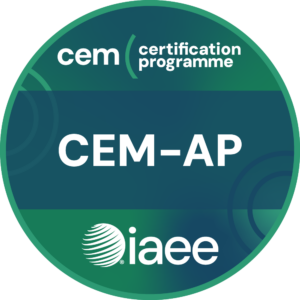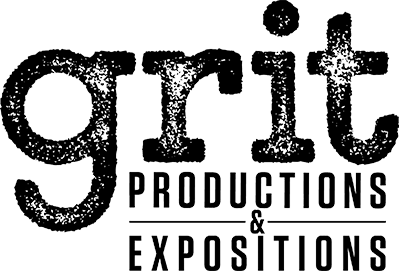CEM-AP (Advanced Professional)
The Certified in Exhibition Management Advanced Professional certification program (CEM-AP) is for CEMs with at least 10 years of industry experience who have acquired 30 credits over the past three years. The 30 credits are from a combination of leadership activities (10 credits) and industry-related professional continuing education (20 credits). The program requires that the CEM complete a CEM-AP course along with a case study. Successful completion of all requirements will award candidates with the CEM-AP certification providing professional credentials. 
The application includes submission and verification of the 30 educational/leadership credits as well as the case study topic. IAEE staff will review and approve the credits and the CEM-AP Case Study Sub-Committee will review and approve the case study topic. After the application and case study topic are received and approved, the applicant will receive an invoice for the application fee ($200 USD for IAEE members/$250 USD for non-members). A case study mentor will also be assigned at this time.
The mandatory course is from two different areas of concentration. Participants do not need to be enrolled in the CEM-AP program to attend a CEM-AP course. Applicants will select one of the following courses which are both two days in length:
- Leading and Negotiating for Success – This course moves the participant beyond the show and provides the skills needed to shift their mindset to innovate, negotiate and enhance strategic thinking skills.
- Mastering Mergers and Acquisitions: Business Development Strategies – This specialized course on business development focuses exclusively on merger and acquisition (M&A) strategies, providing participants with in-depth knowledge and practical skills required to navigate these intricate deals successfully.
- Instructor: Rick McConnell | CEO | Trifecta Collective
- Rick McConnell has a proven track record of acquiring, launching, and growing events. He is a team builder, innovator, idea generator, revenue driver, and partnership expert. From 2009-2014 he led Hanley Wood Exhibitions, growing the portfolio by 67% in four years. As President of Informa Markets North American from 2014-2020, he succeeded in growing annual revenues from $61 million to $425 million through acquisition, organic strategies and digital initiatives. He is the former Chairman of SISO (Society of Independent Show Organizers). He received the IAEE Pinnacle Award in 2020. The award recognizes an individual who, over 20 years, has furthered IAEE’s objectives of advancing exhibitions and events management through the promotion of education, the dissemination of knowledge and the introduction or development of innovative techniques, and who has been dedicated to the perpetuation of the highest ideals, trust and professionalism in this highly specialized field. Rick has an MBA from the University of Arkansas.
Each two-day course costs $1,400 USD for IAEE members and $1,800 USD for non-members.
After the course is successfully completed, applicants have one year from the date of the course to submit their case study. The case study topic, previously approved by the CEM Commission, should be built around one of the 13 CEM courses and should involve an issue and solution that has a significant impact on the exhibitions and events industry.
Case studies may be worked on before the CEM-AP course but may not be submitted until after successfully completing the course. Completed case studies will be sent to the CEM Commission for final approval. Once approved, the CEM-AP certificate is earned.
The CEM-AP recertification process requires the CEM-AP earn a total of 15 education/leadership credits every five years. The CEM designation will automatically be renewed and bundled with the CEM-AP designation.
Application Process/Criteria
Applicants must have an active CEM certification with 10 years industry experience and demonstrate they have earned a minimum of 30 education/leadership credits (since the date of their last CEM recertification OR in the last three years) made up of a combination of leadership activities and professional continuing education attended in the past three years or have earned a master’s degree or advanced degree within the past three years.
Leadership Activities
Ten of the required 30 credits must be earned by participating in exhibitions and events industry leadership activities during the past three years.
Activities include:
- Participation in industry chapter events (luncheons, CSR activities, networking events/meet ups, education) – one (1) contact hour = one (1) credit
- Active participation OR leadership role on an industry or IAEE board, committee, task force or chapter – one (1) credit per term
- Speaker at an exhibitions or events industry event – one contact hour = one (1) credit
- Leading or designing a company sponsored continuing education or training program – one (1) contact hour = one (1) credit
- Guest lecture at a college or university – one (1) contact hour = one (1) credit
- Serve as a mentor (through IAEE or company) – one (1) credit per mentorship
- Participate in community service (ex: PTA board, church volunteer, Girl/Boy Scout Troop activities) = one (1) contact hour = one (1) credit
- Published author = one (1) credit per article
- Proctor a CEM exam = one (1) credit per exam
- Manage a show that is IAEE Certified = one (1) credit hour
- Teach a CEM Learning Program course (online or on-location) – five (5) credits per course
Professional Continuing Education
Twenty of the required 30 credits must be earned by attending professional continuing education. Education credit hours are based on contact hours, which are defined as the number of clock hours spent in direct participation in a structured educational format. One contact hour is equivalent to one credit hour (non-educational time spent networking, on breaks, registration, does not qualify). Education must be industry or leadership-related. All education must occur during the past three years.
Examples include:
- IAEE education programs including:
- Expo! Expo! sessions – one (1) contact hour = one (1) credit
- Webinars = one (1) credit per webinar
- Women’s Leadership Forum (WLF) = five and one half (5.5) credits
- WLF Regional Events = three (3) credits per event
- CEIR Predict – six (6) credits
- Company sponsored continuing education or training: one (1) contact hour = one (1) credit
- Allied association/industry education programs (including, but not limited to CAEM, MPI, ASAE, PCMA, SISO): one (1) contact hour = one (1) credit
Formal Education
If you have earned a master’s degree or advanced degree within the past three years, all required 30 hours may come from this category.
Fees
Application fee is $200 USD for Members/$250 USD for Non-Members. Fees are subject to change without notice and are nonrefundable.
In Case of Audit
All hours/credits are subject to verification by the CEM Commission or IAEE staff through the audit process.
Case Studies
Although case studies may be worked on after the applicant is approved, completed case studies must be submitted after the course is completed. Applicants have one year after the date of the class in which to submit the case study. All case studies will be reviewed and evaluated by the CEM-AP Case Study Sub-Committee. The assigned case study mentor is available for the applicant to work with during the creation of their case study.
Case studies should be built on an issue, challenge or problem that has a significant impact on the exhibitions and events industry. The solution to the problem should be easily demonstrated with measurable outcomes and supported with hard numbers. Charts, tables, graphics, figures and/or statistics should be used to enhance credibility. The applicant should be directly involved in the project in a leadership capacity.
Case Study Elements
- Title of the Case Study (5 points)
- Submission Date
- Name, title, company of CEM-AP candidate
- Company Overview (5 points)
- You can use your standard company’s mission/vision statement
- Introduction/Problem (10 points)
- The introduction and problem should present the company you are discussing and the program you will solve.
- Please include the team members involved in the process and demonstrate how you were directly involved or led the process(s).
- Focus on “pain points” and the impact of that pain on the exhibitions and events industry.
- Discuss symptoms of the problem and its causes such as “resulting from the low attendance at annual meeting, didn’t meet budget.”
- Identify role of stakeholders
- Describe how the problem affected goals and objectives of the organization and which levels were most impacted.
- Analysis of Alternatives (20 points)
- Include various ideas that were discussed
- Discuss approach involved with evaluating each potential solution. What process did you go through?
- Solution (20 points)
- Discuss which solution you chose and why
- Why was this solution better than others?
- Implementation (20 points)
- Describe how your idea was implemented and how it made the overall process better.
- What challenges arose during implementation? How were these solved?
- What tips could help others who are involved in process?
- What parts of the plan were unsuccessful and why?
- How did implementation occur, how long was it?
- Demonstrate how your idea provided a solution to the problem in quantified, measurable terms.
- Results (20 points)
- This must show that your solution chosen was successful and measurable.
- Include graphs, pictures, charts, and/or videos to support.
- Provide summary of benefits from implementing your solution from a stakeholder perspective.
- Include contact information for any references.
- Show how your idea solved the problem. Use hard numbers.
- Demonstrate how solution improved operations.
- Use testimonials.
The applicant must receive at least 80 points or above for their case study to be approved.
If the applicant receives less than 80 points, they will be given the opportunity to re-do their case study and resubmit it for approval within 30 days.




